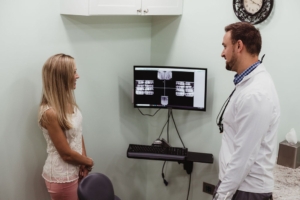Periodontal Therapy
Gum Disease Treatment in Belpre, OH
Periodontal disease, often called gum disease, is a common dental affliction in adults, impacting about 30% of the population. Periodontal disease is the number one cause of tooth loss in adults. Many denture cases are the direct result of advanced gum disease.
While not curable, gum disease is controllable. However, control requires a focused strategy, like managing other types of chronic conditions such as high blood pressure or diabetes. This oral disease can advance in stealth mode with few signs or symptoms in the early stages. In fact, many patients find themselves surprised when alerted to and educated about the quiet damage progressing in their mouths.
Regular dental exams, professional cleanings, and good at-home oral hygiene are essential to preventing and managing periodontitis.
What is Periodontal Disease?
Your gums and the bone that surrounds your teeth provide a strong foundation for your teeth. In response to an ongoing bacterial presence, this foundation is weakened and eventually lost as the bacteria causes the gum and bone tissue to break down. More than 60% of the bone around your teeth can disappear before you begin to experience pain or feel your teeth are loose.
What Causes Gum Disease?
The mouth provides an environment for millions of bacteria, both beneficial and harmful. When this bacteria grows beyond normal, healthy levels, it can quickly escalate into gum disease.
- Bacteria form a sticky plaque that adheres to teeth.
- Without effective brushing and flossing, plaque mineralizes into calculus (tartar).
- Tartar creates a bacterial colony, rapidly increasing bacteria population and pumping toxins into the gums.
- Our gums react to the bacterial invasion with an inflammatory response under the direction of the immune system.
- Around the base of each tooth, a small pocket is formed. This provides a warm, dark environment where deeper tartar and bacterial penetration advance, with their toxins seeping into the base of the gum collar.
- The inflammation that follows causes bleeding, swollen gums (gingivitis).
- Left untreated, this leads to a low-grade, chronic infection in the gum pocket.
- With advancing invasion, the bone begins to deteriorate around the teeth as the bacteria burrow deeper into the foundation. While the gums may be slightly tender at this stage, there’s generally no to minimal discomfort or pain as the bone dissolves.
- The bone around teeth never regenerates, so this loss becomes permanent, making the condition harder to control as the bacteria go deeper into the gums.
- Untreated gum disease leads to abscess and generalized tooth loss.
Diagnosis
We start by employing objective clinical data to form a gum disease diagnosis and to classify the severity of the condition. Utilizing multiple indicators and assessment tools, a clear picture of your periodontal health can be determined and the best treatment for you can be proposed.
Indicators in Diagnosis of Gum Disease:
- Measurements of the pockets around the teeth
- Measurements of the gum attachment levels
- Assessment of the texture and shape of your gums
- Evaluation of tooth mobility
- Bone density levels
Professional, Judgement-Free Treatment
After your diagnosis, a personalized treatment plan can be developed with you.
Milder cases of gum disease, with little or no bone loss, can usually be brought under control in one or two appointments with our highly-trained dental hygienist. Patients leave these appointments with a strategy for daily home care and an established schedule for routine professional cleanings.
In cases involving bone loss, a proactive approach to halt further destruction will be strongly recommended.
A periodontal appointment in our office will begin with a gentle numbing of your gums for your comfort as we thoroughly remove plaque and tartar. One area at a time undergoes meticulous cleaning above and below the gum line, usually over two visits.
The infected pocket around each tooth must be carefully cleaned with hand and ultrasonic instruments. Polishing of the teeth to establish glassy surfaces that help repel plaque accumulation is usually the last step of this initial therapy.
Critical Care
Daily at-home care is critical. Dr. Huffman may suggest a medicated rinse, a water flosser, an electric toothbrush, or another specific tool to help you manage gum disease.
Routine appointments in our office are also essential as the deeper sections of gum pockets previously overwhelmed by bacteria are impossible to reach at home without the expertise and tools of a professional.
Mouth-Body Connection
Current research continues to establish clear links between bacterial disease in your mouth and ailments in other parts of the body. Studies show a link between oral bacteria and conditions such as heart disease, stroke, arthritis, erectile dysfunction, Alzheimer’s, and diabetes.
Diabetes and auto-immune disorders lower the body’s ability to fight infection, therefore allowing gum disease to advance faster. Research also confirms that inflammation in the mouth can aggravate diabetes, making it harder to control blood sugar levels. This bidirectional relationship between two chronic diseases is just one example of the importance of optimal oral health.
Save Your Smile: Gum Disease impacts 30% of the adult population.
Learn more about what we offer:

